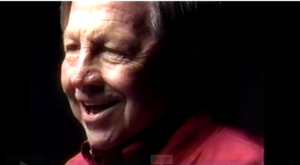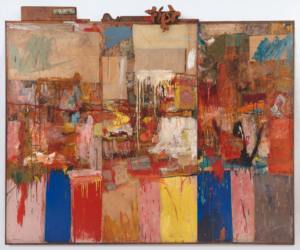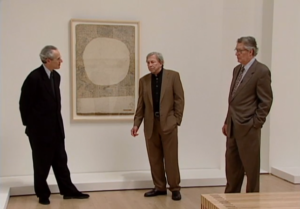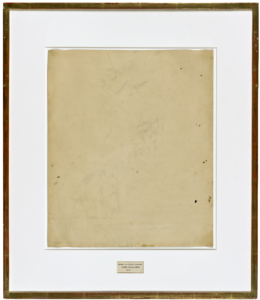SFMOMA: Robert Rauschenberg has a very long history with SFMOMA. What does it mean to show a retrospective of his work, now, based on where we are and his place in art history?
Gary Garrels: This is the first retrospective to be organized since Rauschenberg died in 2008. There was a massive retrospective at the Guggenheim in New York in 1997–98, which he was deeply involved in, along with Walter Hopps, the curator there. They had worked very closely on his first big overview exhibition, let’s call it a mid-career retrospective, in 1976 at what is now the Smithsonian American Art Museum.
SFMOMA: So is this the first time that Rauschenberg has not been involved in a major exhibition of his work?
GG: Right. It’s common for an artist to be most interested in their newest work — what’s driving them at the moment. So those exhibitions where Rauschenberg was most involved were heavily weighted toward his more recent work. We’ve tried to create a balanced continuum from the beginning of his career right through to the very last work that he made. You’ll see the continuity, the textures, the relationships — it’s the web of his sixty-year career.
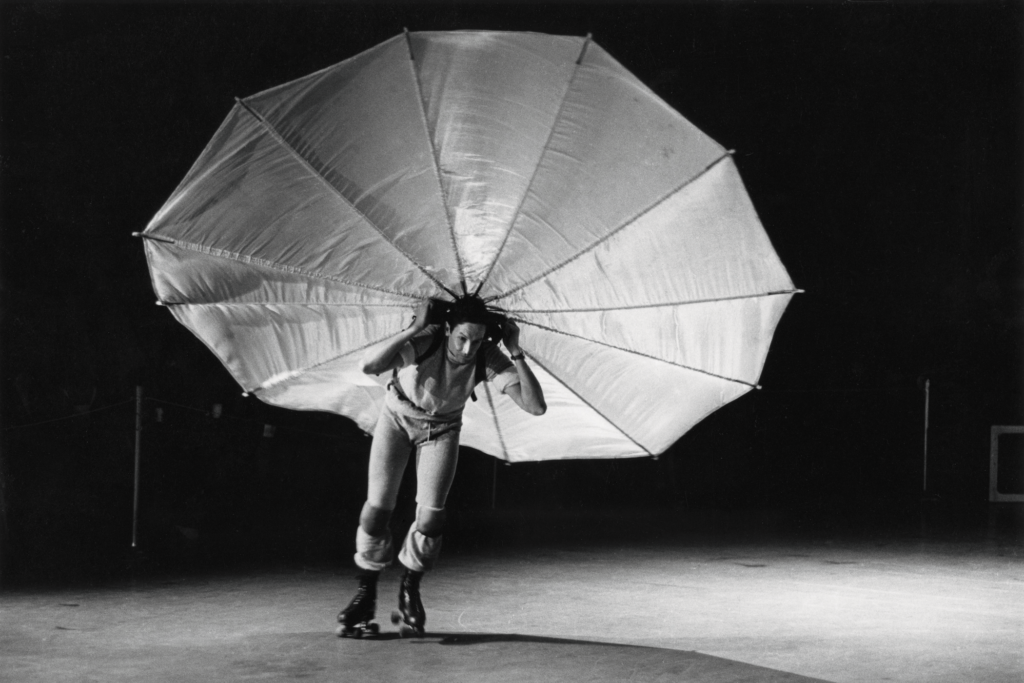
Peter Moore, Photo of Rauschenberg performing his piece Pelican (1963), First New York Theater Rally, 1965; © Barbara Moore / Licensed by VAGA, New York, NY; courtesy Paula Cooper Gallery, New York
SFMOMA: Has certain thinking about Rauschenberg changed since he passed away? And if yes, how has it informed this exhibition?
Sarah Roberts: One major shift is that we’re emphasizing his collaborations — the people he worked with who fueled his thinking and creativity. Also his multidisciplinary work: for example, he worked with choreographer Merce Cunningham from the mid-1950s right up to the end of his life, and with Trisha Brown on many of her dance compositions. Rauschenberg’s work in performance hasn’t been widely appreciated previously, so having that woven through our exhibition is new.
GG: Many galleries will be showing footage of performances and dances where he designed the sets or costumes, or even performed himself. For instance he first collaborated with Cunningham in 1954, just as he was also the beginning some of his most famous works, the Combines. Those were three-dimensional assemblages bringing together a wide variety of materials and images. One of the very first foundational works was a piece called Minutiae (1954), which he made as a dance set for the Cunningham company. We’ll have it in the exhibition.
SR: With video of the dancers onstage next to the piece.
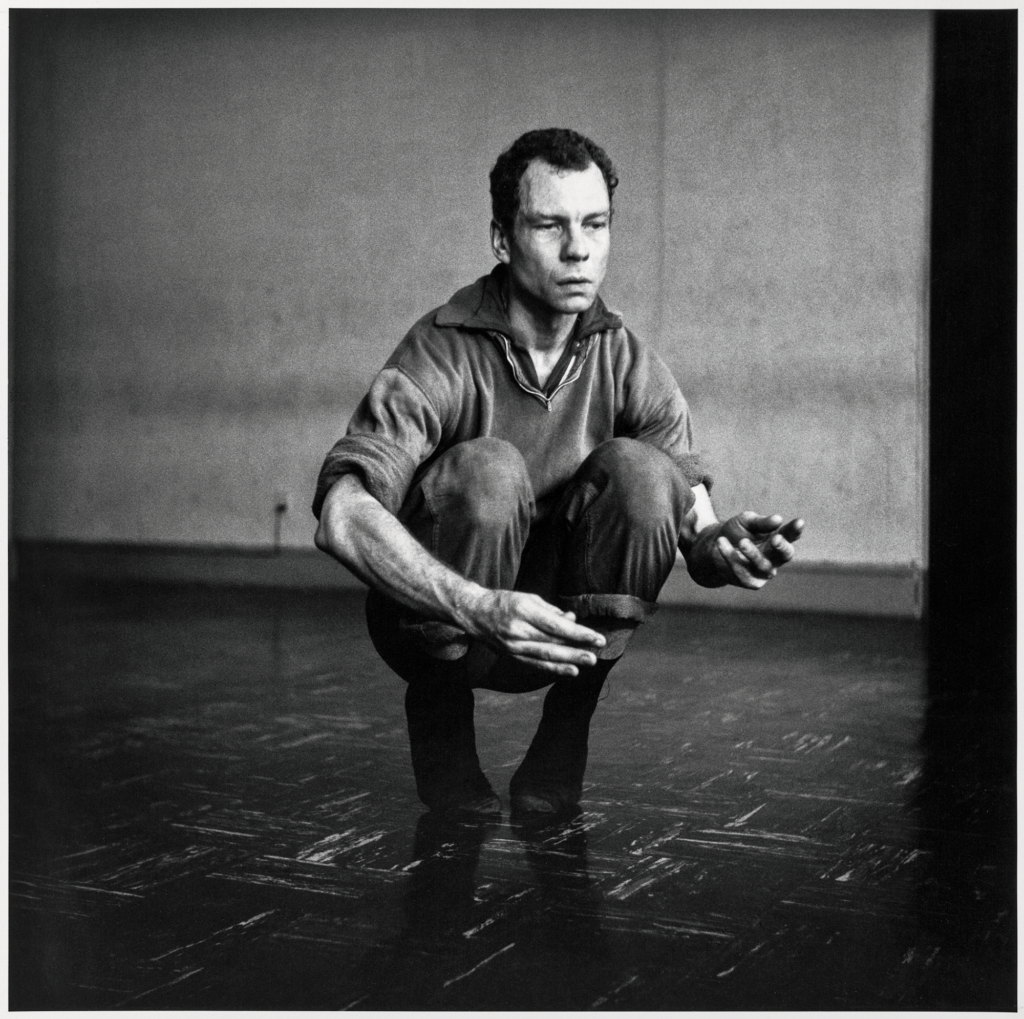
Robert Rauschenberg, Merce, 1953, printed 1981; collection SFMOMA, purchase; © Robert Rauschenberg Foundation
SFMOMA: How are you going to explain the innovative aspects of some of Rauschenberg’s undertakings, like the Combines, to contemporary audiences who may not immediately understand how they broke the rules of art at the time?
SR: We’ll talk about how it started very early on with the fundamentals of art that he learned from Josef Albers — who emphasized understanding your materials and the basics of color and composition — and then you see Rauschenberg flipping that all on its head by doing things like making an all-white painting. The Combines are about bringing everything outside of painting into painting, but if you look at them carefully, most of them have a solid compositional foundation, like Collection (1954/1955). It’s a triptych and has an underlying grid structure that could be called very traditional. But the materials are completely unexpected and nearly chaotic. That strategy of working with conventions while simultaneously exploiting or overturning them pops up over and over again.
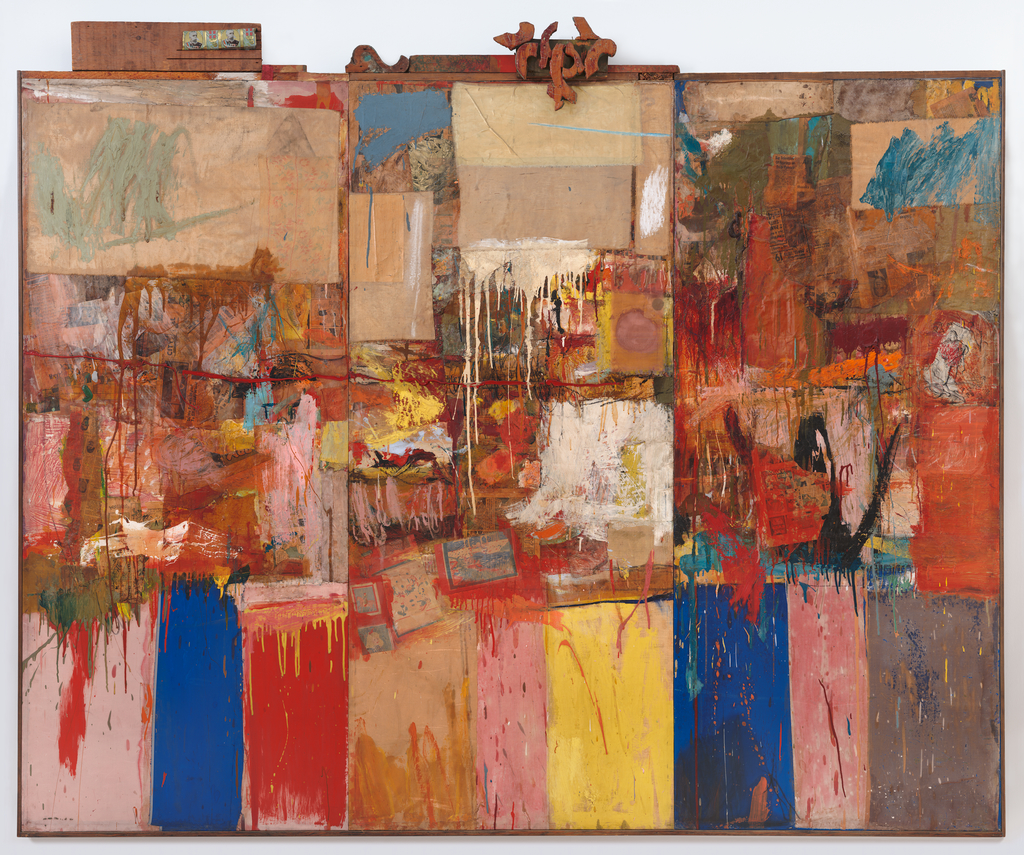
Robert Rauschenberg, Collection, 1954/1955; collection SFMOMA, gift Harry W. and Mary Margaret Anderson; © Robert Rauschenberg Foundation
GG: He was very interested in images. He recognized, before we were all having this conversation, that we live in an image world, saturated with images. He loved that, but he was also interested in the physicality of the image — how an image manifests as a thing that you can crop, distort, layer, transfer, make a transparency. For me, one of the most interesting things about Rauschenberg’s work is the constant tension, point-counterpoint, between material physicality and image.
SFMOMA: What are some things in the show that will be surprising to someone who’s already familiar with Rauschenberg?
GG: It’s true that people who are interested in contemporary art have seen a lot of images of Rauschenberg’s work, because he’s a major figure. But even the best-known pieces are wild to actually see in person. For instance Monogram (1955–59), the goat with the tire around it, is absolutely shocking to see in person. It’s such a crazy thing. Preposterous. But in reproduction you don’t see all the detail, and the fact that the goat is standing on another work, which if you put it on the wall, would be another assemblage or Combine.
SR: It’s very funny.
GG: It is. The other thing you don’t notice in photos is that the goat’s head is covered with paint, like somehow the goat has been rooting around in the studio. And that’s just one example. It’s not until you’re standing there in front of the work that all of the subtleties blossom.
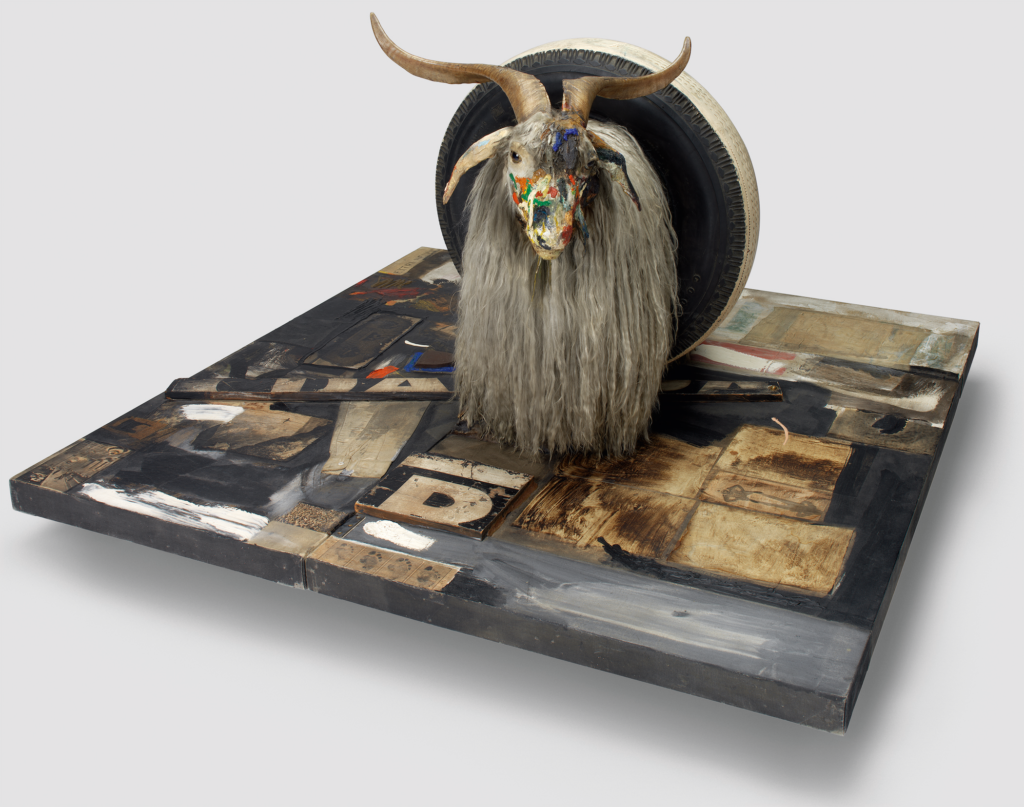
Robert Rauschenberg, Monogram, 1955–59; Moderna Museet, Stockholm, purchase 1965 with contribution from The Friends of Moderna Museet; © Robert Rauschenberg Foundation
SR: A lot of it is simply difficult to capture in a reproduction, especially some of the later works on metal. As you move in front of them, they’re like holograms — things come in and out of focus that you can’t see in a photograph.
GG: Doubling and reversals are intrinsic to the work, I’m sure in part because that was hard-wired in his own perceptual systems. Rauschenberg had very serious dyslexia, and once you know that about him, you have another insight into the work.
SR: Yes, how the images play off of each other and how he was taking in the world, absorbing this flood of images, and making sense of it — or not making sense of it, and rearranging it.
SFMOMA: I’ve heard that the White Paintings are supposed to be repainted every once in a while. Can that be true?
GG: You have to understand, those works are essentially interactive. They require a viewer having an experience with them, seeing light and shadows on them, to actually become works of art. Otherwise, they’re just — I don’t know what you’d call them.
SR: They’re waiting.
GG: That’s a good way to put it.
SR: And yes, there is a protocol for repainting them because they’re supposed to be pristine, blank, white surfaces. They’re not allowed to age or acquire a patina. There’s a specific Benjamin Moore color to use, and we have had long conversations regarding how frequently repainting would be appropriate. Ours was repainted for the last big retrospective in the 1990s, which was before it came into SFMOMA’s collection in 1998. So far, we have only talked about it and done tests — we haven’t had to repaint it.
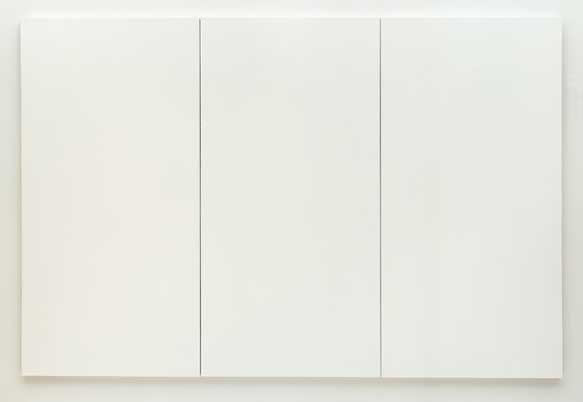
1. Robert Rauschenberg, White Painting [three panel], 1951; latex paint on canvas, 72 in. x 108 in. (182.88 cm x 274.32 cm); Collection SFMOMA, Purchase through a gift of Phyllis Wattis; © Robert Rauschenberg Foundation / Licensed by VAGA, New York, NY
SFMOMA: The exhibition is titled Erasing the Rules. I’m thinking of Rauschenberg coming of age as an artist in the midst of a very structured Abstract Expressionist moment. How much can we call his practice a rejection of that movement’s focus on the primacy of painting?
SR: He came of age in New York from 1949 to 1951 or 1952, indeed saw all of those foundational shows of the major Abstract Expressionist figures. I think, like every artist, he was trying to make a name for himself by doing something different. There certainly was an element of willfully trying to distinguish himself. And he could be a bit abrasive — he liked to shake things up, and didn’t mind irritating people in the process.
The other important element, socially, is that he was gay. There was this macho heterosexual aspect to the whole Abstract Expressionist scene, and Rauschenberg and Jasper Johns and Merce Cunningham and John Cage formed this close circle of mutual support as four gay men living in New York City at a time when it was a crime to be gay. Joseph McCarthy’s House Un-American Activities Committee was persecuting people and equating being gay with being a Communist. That social support of Cage, Johns, and Cunningham, their separation from the Abstract Expressionist scene — he described it as giving him permission to run counter to that whole ethos and break its rules. To be willing, for example, to insert a necktie into what otherwise might have been a “pure” painting. A lot of those early Combines are quoting Abstract Expressionism. There’s the big juicy brushstroke, but it’s juxtaposed with all of these other materials, like comic strips and umbrellas. So it becomes a found object rather than a stroke of paint.
GG: I would say it was subversive, but not an explosive challenge of the rules. More rupturing and playful.
SR: When he first showed the Red Paintings and Combines, with their bright, garish colors and things that lit up, mirrors, umbrellas, all these crazy things, people were offended because they thought he was making fun of how serious they were about painting. The works’ playfulness upset people. There wasn’t room at that time for humor in the high temple of painting.
GG: It goes right back to one of the most iconic works of his whole career, the Erased de Kooning Drawing (1953), whose story has been told so many times. Rauschenberg himself told the story numerous times, of going to the studio of Willem de Kooning, who was a hero of his, but also someone he knew — knew well enough to show up with a big bottle of whiskey. Was it scotch, or do we know?
SR: Jack Daniel’s.
GG: Okay. To show up at the door of de Kooning, who liked to drink — Rauschenberg liked to drink, too — and propose to erase one of de Kooning’s drawings. De Kooning considered it and said, okay, I get what you’re doing. I’ll go along with it, but I’m not going to make it easy. So he pulled out a very rich, dense, complex drawing that he knew would be hard to erase.
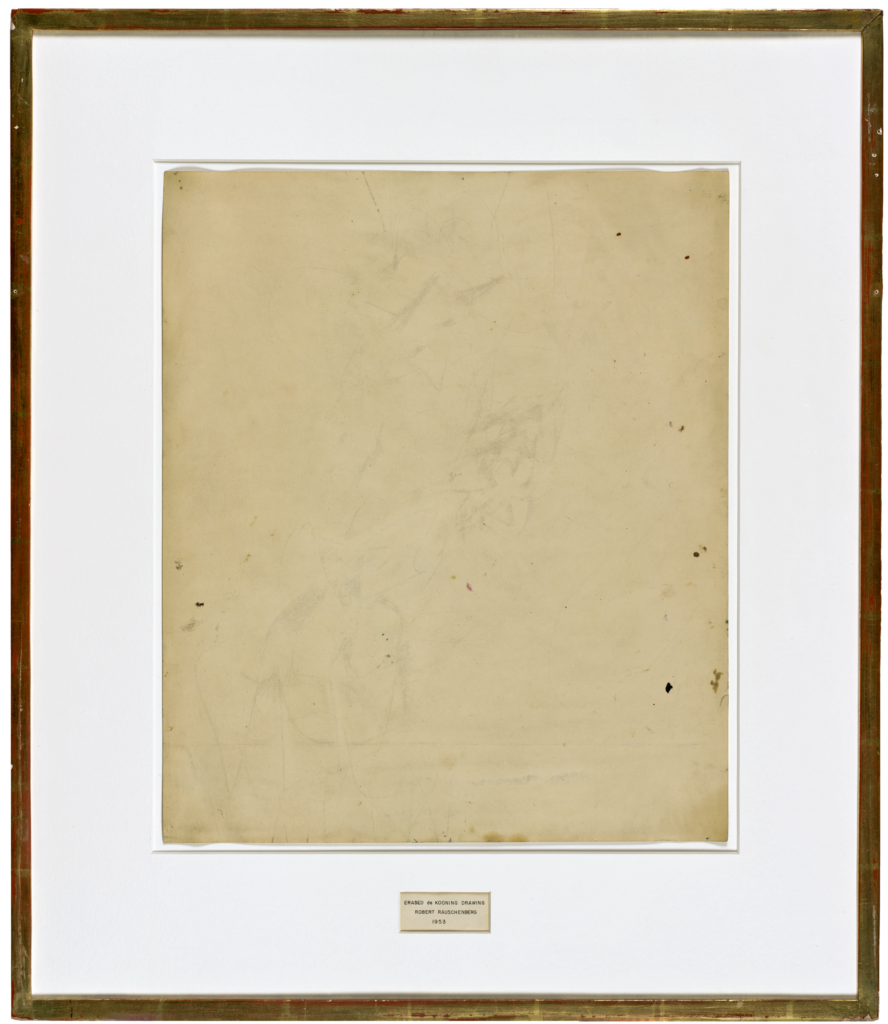
Robert Rauschenberg, Erased de Kooning Drawing, 1953; collection SFMOMA, purchase through a gift of Phyllis C. Wattis; © Robert Rauschenberg Foundation
SFMOMA: It’s frequently been characterized as an Oedipal killing of the father figure.
SR: But it was also hero worship. He identified the guy he thought was undeniably, indisputably at the top of the game of making art.
GG: Just as de Kooning was famous for saying that Picasso was the man you had to beat —
SR: — for Rauschenberg, de Kooning was the guy to beat.
GG: Also, few people know that after he did it, the erased drawing just went into a drawer.
SFMOMA: I was just going to ask what happened after that.
SR: People heard that he’d done it and thought it was outrageous, but it wasn’t being shown.
GG: It wasn’t yet an object; it was just a story, an anecdote that made the rounds among artists in downtown New York. It wasn’t until 1955, I believe — Jasper Johns told me this story over lunch one day — that he and Rauschenberg were invited to be in a drawing show, and Johns had drawings, but Rauschenberg didn’t have any. And Johns said, oh, well, you’ve got the erased de Kooning. And so they pulled it out of the drawer and took it to a frame shop and Johns made the label. Then it became the final work of art.
SFMOMA: So from concept to execution, that piece was collaborative.
GG: The idea that it’s a Johns-Rauschenberg collaboration has only been assimilated fairly recently. It’s like the Automobile Tire Print (1953), which was made with John Cage but was always called a Rauschenberg work. Rauschenberg would often have an idea and then figure out a way to execute it that involved having other people work with him.
Andy Warhol was deeply affected by Rauschenberg and Jasper Johns and the idea of the studio — Warhol called it a Factory — as a place where ideas ferment and are shared. The antithesis of the Abstract Expressionist idea of painter isolated alone in his studio with a canvas —
SR: — expressing pure, unadulterated individualism and subjectivity.

Robert Rauschenberg, Automobile Tire Print, 1953 (detail); collection SFMOMA, purchase through a gift of Phyllis C. Wattis; © Robert Rauschenberg Foundation / Licensed by VAGA, New York, NY; photo: Ben Blackwell
GG: Rauschenberg enjoyed the surprise of what would happen when one image ended up next to another. It wasn’t something that he tried to control, or forecast, or predict.
SR: He liked the happy accidents.
GG: He’d see something happen and be excited and keep it.
SR: And figure out how to amplify it, or use it to his advantage in a different way next time.
GG: I once asked him how he’d chosen an image, and he absolutely refused to consider that. It wasn’t about choice. It was more like a stream of consciousness and discovery in the process of looking.
SR: He loved the advent of digital printing toward the end of his life. He could have a stack of two or three hundred printed images ready to go, and flip through and pull something out. It wasn’t the same as having to choose a photograph and have a silkscreen made — a delayed, multistep process. It was absolutely immediate, and if he didn’t have the size he wanted, he’d say, “Hey, print this bigger,” and it would be there in five minutes and he could work it into a transfer painting on the spot. The immediacy of the digital technology matched the speed with which his brain was flipping through images.
GG: In some ways not unlike what a traditional painter does in a studio. You’re putting a brush down on canvas and making a mark, then responding to what happens with that mark and then another. He was putting down one image at a time and responding. It’s a back-and-forth between the intuitive and the conscious, between the happy accident and the control.
